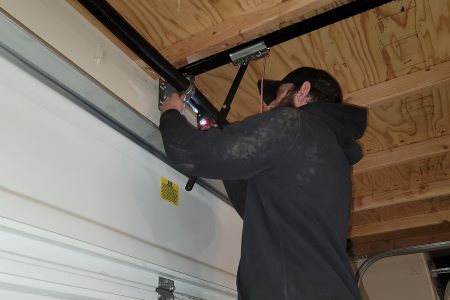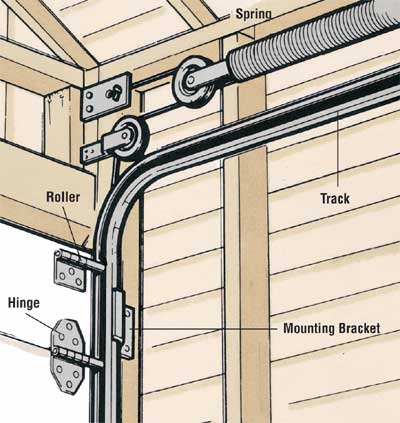Typical Garage Door Problems and Exactly How to Deal with Them
Garage doors are vital for both safety and security and ease, yet they frequently provide a range of typical problems that can irritate home owners. Troubles such as too much sound during operation, doors that stop working to open or close, misaligned tracks, and malfunctioning remotes can occur without warning. While some problems may appear straightforward to deal with, others may require a more nuanced understanding of garage door mechanics. Dealing with these problems efficiently not only enhances capability but additionally prolongs the life of the door. One might wonder what actions are essential to deal with these obstacles efficiently.
Noisy Garage Door Procedure
A noisy garage door operation can be a significant source of inconvenience for homeowners, often indicating underlying mechanical concerns. Such disturbances might stem from various causes, including damaged rollers, loosened hardware, or insufficient lubrication. Identifying the resource of the noise is important for efficient resolution.
Over time, these components can wear away, leading to grinding or squealing audios as the door relocations. In addition, loose screws or screws in the door system can produce rattling audios during operation.
An additional contributing element is poor lubrication of the door's relocating components. Applying a premium lubricant to the tracks, springs, and rollers can significantly decrease friction and sound. Property owners should perform this maintenance regularly to preserve optimal performance.
Lastly, the garage door opener may additionally generate sound as a result of its age or mechanical issues. If the sound persists in spite of resolving various other elements, speaking with an expert for a detailed inspection and potential repair work may be required.
Door Won't Open or Shut
Experiencing a garage door that will not open up or shut can be unbelievably irritating and usually signals a malfunction within the system. Numerous variables can add to this problem, and determining the root cause is important for effective resolution.

Next, evaluate the security sensing units located at the base of the door. These sensors can come to be misaligned or obstructed by debris, preventing the door from operating appropriately. Clean the sensors with a soft towel and guarantee they are aligned.
In addition, the garage door's internal elements must be examined. Problems such as a busted spring, worn-out rollers, or a harmed opener can restrain movement. If any type of parts seem damaged, it may be a good idea to consult an expert for repair services.
Misaligned Tracks
(Reliable Partners)Misaligned tracks can seriously disrupt the smooth operation of a garage door, leading to operational failings such as uneven motion or full immobilization. This problem typically occurs due to a selection of factors, consisting of damage, unexpected effects, or improper setup. When the tracks are misaligned, the rollers can not move freely, which not just stresses the motor but additionally presents security risks.
If you see any type of inconsistencies, it is critical to deal with the issue immediately. Carefully touch the track back into its right position utilizing a rubber club or a similar device, ensuring it is straight and level.
Routine upkeep, including cleaning the tracks and making sure rollers are in excellent condition, can avoid future imbalances. By addressing misaligned tracks quickly, you can bring back the capability of your garage door and enhance its longevity.
Broken Springs
Among the different parts of a garage door system, broken springs are among the most usual concerns that can substantially hamper its capability. Garage door springtimes are essential for balancing the weight of the door, enabling for smooth opening and closing. When a springtime breaks, it can cause a door that is hard to run or, in some cases, completely inoperable.
There are two main types of springs: torsion springs, which are mounted above the door, and expansion springtimes, located on either side. Indicators of a broken spring consist of a door that will not open up, a noticeable space in the spring, or a loud sound throughout operation. Attempting to operate a garage door with a damaged springtime can trigger more damage to the door or the opener.
Fixing damaged springtimes is not a do it yourself task; it calls for specialized tools and know-how because of the high stress entailed. It is suggested to consult a specialist service technician that can securely change the springs and guarantee the door is appropriately balanced. Routine upkeep and assessments can assist prevent spring failures and expand the life-span of the garage door system.
Push-button Control Issues

If the remote still stops working to operate, inspect the garage door opener to make certain that its sensing units are tidy and unblocked. Dust, particles, or imbalance may hinder the signal transmission in between the remote and the opener.
Disturbance from directory other electronic tools can likewise hinder remote performance. Ensure that neighboring tools, such as wireless routers or cordless phones, are not causing disturbances. garage door service. If disturbance is thought, attempt relocating these devices better far from the garage door opener
In many cases, the remote might require to be reprogrammed. Seek advice from the producer's standards to reset the push-button control and synchronize it with the garage door opener. If all else falls short and the remote remains to malfunction, consider getting in touch with an expert technician for a comprehensive inspection and possible replacement of the remote or opener.
Verdict
(Comprehensive Coverage)In summary, usual garage door problems can dramatically affect capability and safety. Dealing with loud procedure involves lubrication and tightening equipment, while concerns with opening or closing call for inspection of power sources and sensing units. Misaligned tracks can be corrected via modification, although damaged springtimes demand professional intervention. Remote control malfunctions commonly occur from weak batteries or disturbance, which can be dealt with with substitute or reprogramming. Proactive upkeep and prompt fixings can guarantee optimal efficiency and longevity of garage doors.